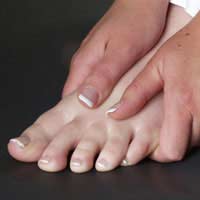What Could Cause Painful Bunions?
Overview
 A bunion is a foot deformity where your big toe slants outward horizontally, pushing the tip of the big toe up against your little toes, and creating a characteristic sharp angle along the inside of your foot, at what?s called the first metatarsophalangeal joint-where your big toe connects to your foot. The reason for the deformity is an abnormal growth of bone, so it is not a condition that will correct itself naturally. Though bunions, or hallux valgus, as they are known in the medical community, are well-known among the general population for causing pain and discomfort, they can have a big impact on your running as well. Women?s marathon world record holder Paula Radcliffe, for example, lost several months of running because of a bunion on her foot.
A bunion is a foot deformity where your big toe slants outward horizontally, pushing the tip of the big toe up against your little toes, and creating a characteristic sharp angle along the inside of your foot, at what?s called the first metatarsophalangeal joint-where your big toe connects to your foot. The reason for the deformity is an abnormal growth of bone, so it is not a condition that will correct itself naturally. Though bunions, or hallux valgus, as they are known in the medical community, are well-known among the general population for causing pain and discomfort, they can have a big impact on your running as well. Women?s marathon world record holder Paula Radcliffe, for example, lost several months of running because of a bunion on her foot.
Causes
Women traditionally have a higher rate of bunions, which is to be expected, since it is they who have traditionally worn shoes with high heels, a narrow toe box, or whatever fashion dictates from year to year. However, men can suffer from bunions as well, as can anyone for whom the right (or wrong) conditions exist, poor foot mechanics, improper footwear, occupational hazards, health and genetic predisposition. Finally, bunions have long been a condition associated with the elderly, and although they often appear in conjunction with inflammatory joint diseases such as arthritis (which is often associated with age), they can strike at any point in life, including adolescence.
Symptoms
The major symptom of bunions is a hard bump on the outside edge of the foot or at the base of the big toe. Redness, pain and swelling surrounding or at the MTP joint can also occur.
Diagnosis
Bunions are readily apparent - the prominence is visible at the base of the big toe or side of the foot. However, to fully evaluate the condition, the foot and ankle surgeon may take x-rays to determine the degree of the deformity and assess the changes that have occurred. Because bunions are progressive, they don?t go away, and will usually get worse over time. But not all cases are alike - some bunions progress more rapidly than others. Once your surgeon has evaluated your bunion, a treatment plan can be developed that is suited to your needs.
Non Surgical Treatment
Bunions may be treated conservatively with changes in shoe gear, different orthotics (accommodative padding and shielding), rest, ice and medications. These sorts of treatments address symptoms more than they correct the actual deformity. Surgery, by an orthopedic surgeon or a podiatric surgeon, may be necessary if discomfort is severe enough or when correction of the deformity is desired. Orthotics are splints or regulators while conservative measures include various footwear like gelled toe spacers, bunion toes separators, bunion regulators, bunion splints and bunion cushions. There are a variety of available orthotics (or orthoses) including over-the-counter or off-the-shelf commercial products and as necessary, custom-molded orthotics that are generally prescribed medical devices. 
Surgical Treatment
Arthrodesis involves fusing together two bones in your big toe joint (metatarsophalangeal joint). The procedure is usually only recommended for people with severe deformities of the big toe joint, which make it too difficult for doctors to completely fix the joint, or when there's advanced degeneration of the joint. After arthrodesis, the movement of your big toe will be severely limited and you won't be able to wear high heels. An excision arthroplasty involves removing the bunion and the toe joint. A false joint is created by scar tissue that forms as a result of the operation. The procedure involves pinning the joint in place with wires, which will be removed around three weeks after surgery is carried out. An excision arthroplasty can only be used in certain circumstances, and is usually reserved for severe, troublesome bunions in elderly people.